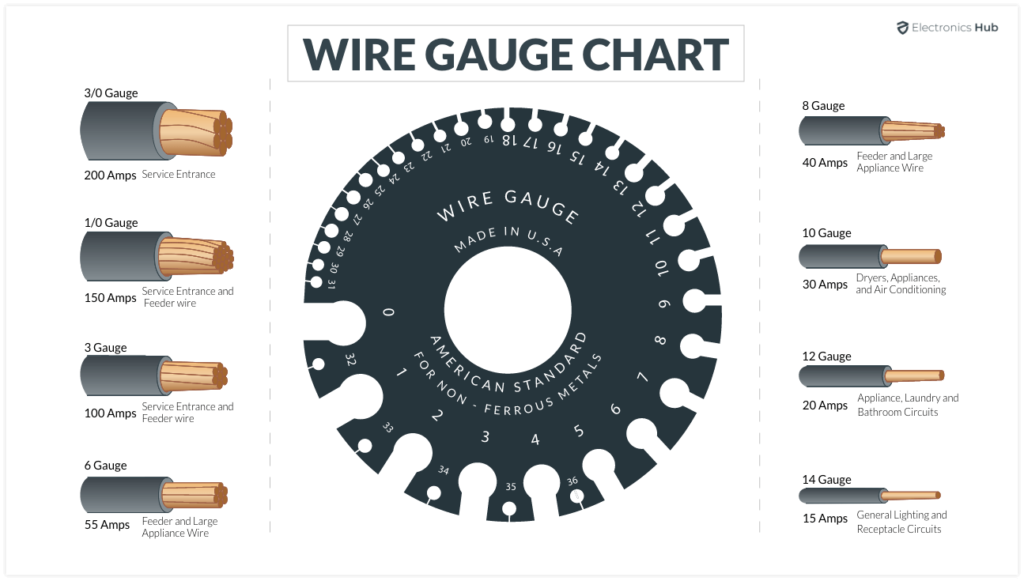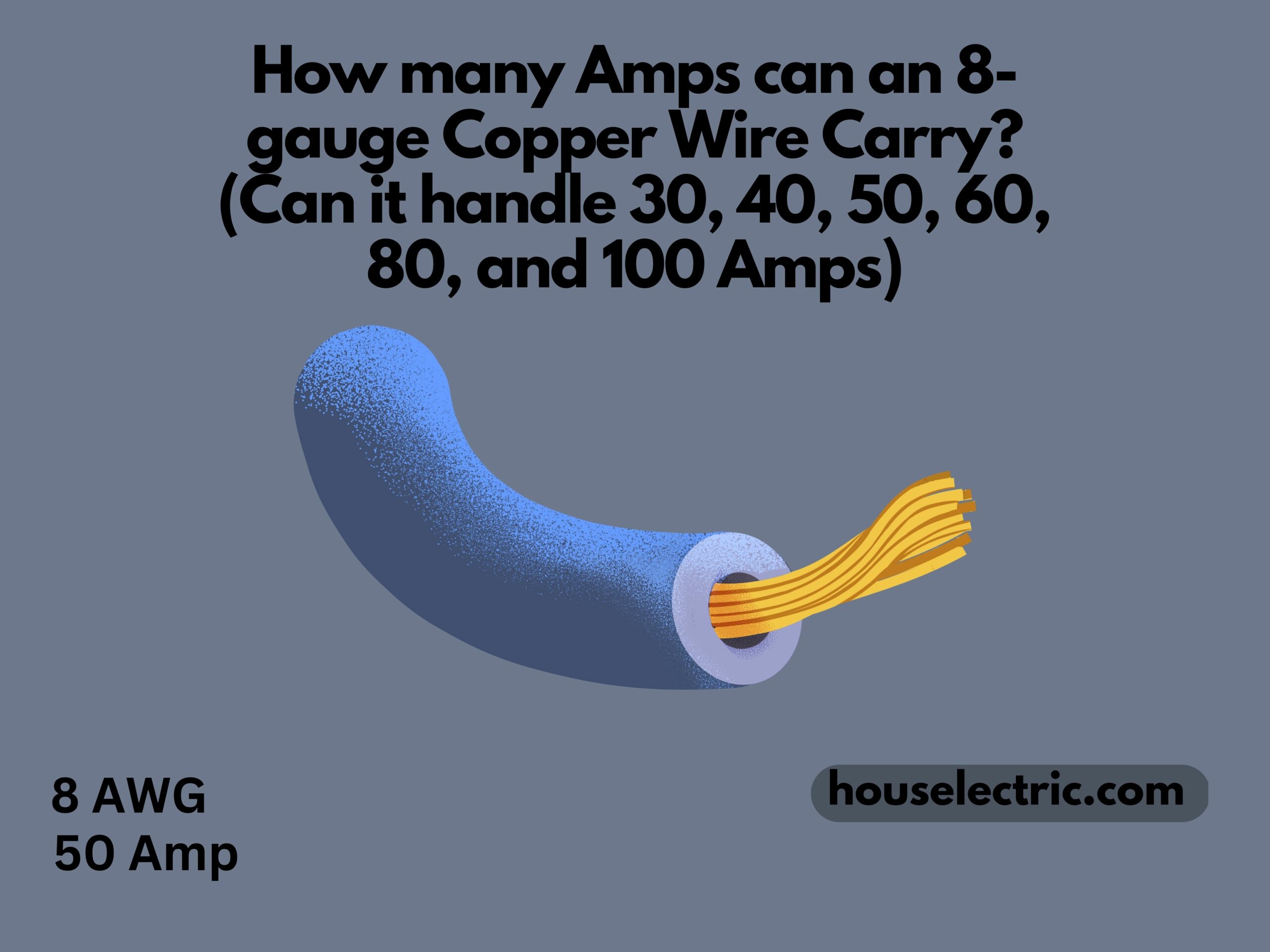Before using an 8-gauge copper wire a person should have proper information about how many amps it can handle. if you install it without knowing the wire will melt down due to exceeding the amps rating. So, this article will guide you about how many amps an 8-gauge copper wire can carry.
How many amps can an 8-gauge copper wire carry?
The following is a detailed explanation of whether they can carry 30,40,50,60,80,100 amps:

Can they handle 30 amps
We should always prefer to use bigger wires than smaller ones because they can carry as much electricity without heating the wire. An 8-gauge copper wire is considered good to handle 30 amps which is low electricity. You can also use either material such as copper or aluminum to carry 30 amps as both can handle it effectively.
Can it handle 40 amps:
An 8-gauge copper wire is mostly preferred use to carry 40 amps of electricity because it provides more flexibility and is safe. Using 8 gauge solid copper to carry 40 amps will not increase the temperature of the wire. If we compare the material of wire i. e copper and aluminum both can handle it but copper is considered a more preferred type in case of an increase of amps in the future.
Can it handle 50 amps:
An 8-gauge copper wire can handle 50 amps of electricity but after some time it may start to get heated up. So for handling 50 amps of electricity you should have a bigger size of wire. For example, a 6 gauge wire is good to use to carry 50 amps as it will not increase the temperature of the wire.

If you use an 8-gauge copper wire to carry 50 amps then the copper wire reaches 167 degrees F. And the material aluminum 8 gauge wire is not even able to handle it. So an 8-gauge copper wire should only be used for electricity upto 40 amps or less than it because if the amps increase more than 40 amps the temperature will increase and the wires will melt down.
Can it handle 60 amps:
To carry 60 amps of electricity it is very dangerous to use an 8-gauge copper wire. you should not use a wire of less than 6 gauge to carry 60 amps of electricity. If you use an 8 gauge wire to carry 60 amps the wires will melt and which will lead to destroying the appliances and there is the possibility of catching fire.
Can it handle 80 amps:
An 8 gauge wire whether copper or aluminum will heat up, melt and will lead to fire so to increase safety we recommend you use a 2 gauge wire for 80 amps as it will handle the electricity safely. A copper 3 gauge wire also can be used for 80 amps because the wire has better ampacity than aluminum.

Can it handle 100 amps:
An 8-gauge copper wire is totally incapable to handle 100 amps.100 amps is a lot of electricity and you should use a proper size of wire such as 3 gauge copper wire.
The standard temperature of the 8 gauge wire is about 140 F Or 60 C. And using an 8 gauge wire with 55 amps of electricity the temperature of the wire reaches upto 194 F so we can say that it is totally unsafe to use 8 gauge wire with more than 50 amps of electricity.
AWG wire gauge chart:
The following chart will help you to know about standard copper wire and very AWG wire explaining the diameter, cross-section, and ampacity of the different wires.
| AWG Number | Diameter (inches) | Diameter (mm) | Cross-Section (mm2) | Ampacity (at 75°C) |
| 0000 (4/0) AWG | 0.4600 in | 11.684 mm | 107 mm2 | 230 Amp |
| 000 (3/0) AWG | 0.4096 in | 10.405 mm | 85.0 mm2 | 200 Amp |
| 00 (2/0) AWG | 0.3648 in | 9.266 mm | 67.4 mm2 | 175 Amp |
| 0 (1/0) AWG | 0.3249 in | 8.251 mm | 53.5 mm2 | 150 Amp |
| 1 AWG | 0.2893 in | 7.348 mm | 42.4 mm2 | 130 Amp |
| 2 AWG | 0.2576 in | 6.544 mm | 33.6 mm2 | 115 Amp |
| 3 AWG | 0.2294 in | 5.827 mm | 26.7 mm2 | 100 Amp |
| 4 AWG | 0.2043 in | 5.189 mm | 21.2 mm2 | 85 Amp |
| 5 AWG | 0.1819 in | 4.621 mm | 16.8 mm2 | – |
| 6 AWG | 0.1620 in | 4.115 mm | 13.3 mm2 | 65 Amp |
| 7 AWG | 0.1443 in | 3.665 mm | 10.5 mm2 | – |
| 8 AWG | 0.1285 in | 3.264 mm | 8.37 mm2 | 50 Amp |
| 9 AWG | 0.1144 in | 2.906 mm | 6.63 mm2 | – |
| 10 AWG | 0.1019 in | 2.588 mm | 5.26 mm2 | 35 Amp |
| 11 AWG | 0.0907 in | 2.305 mm | 4.17 mm2 | – |
| 12 AWG | 0.0808 in | 2.053 mm | 3.31 mm2 | 25 Amp |
| 13 AWG | 0.0720 in | 1.828 mm | 2.62 mm2 | – |
| 14 AWG | 0.0641 in | 1.628 mm | 2.08 mm2 | 20 Amp |
| 15 AWG | 0.0571 in | 1.450 mm | 1.65 mm2 | – |
| 16 AWG | 0.0508 in | 1.291 mm | 1.31 mm2 | 17 Amp |
| 17 AWG | 0.0453 in | 1.150 mm | 1.04 mm2 | – |
| 18 AWG | 0.0403 in | 1.024 mm | 0.823 mm2 | 14 Amp |
| 19 AWG | 0.0359 in | 0.912 mm | 0.653 mm2 | – |
| 20 AWG | 0.0320 in | 0.812 mm | 0.518 mm2 | 11 Amp |
| 21 AWG | 0.0285 in | 0.723 mm | 0.410 mm2 | – |
| 22 AWG | 0.0253 in | 0.644 mm | 0.326 mm2 | 7 Amp |
| 23 AWG | 0.0226 in | 0.573 mm | 0.258 mm2 | – |
| 24 AWG | 0.0201 in | 0.511 mm | 0.205 mm2 | 3.5 Amp |
| 25 AWG | 0.0179 in | 0.455 mm | 0.162 mm2 | – |
| 26 AWG | 0.0159 in | 0.405 mm | 0.129 mm2 | 2.2 Amp |
| 27 AWG | 0.0142 in | 0.361 mm | 0.102 mm2 | – |
| 28 AWG | 0.0126 in | 0.321 mm | 0.0810 mm2 | 1.4 Amp |
| 29 AWG | 0.0113 in | 0.286 mm | 0.0642 mm2 | – |
| 30 AWG | 0.0100 in | 0.255 mm | 0.0509 mm2 | 0.86 Amp |
| 31 AWG | 0.00893 in | 0.227 mm | 0.0404 mm2 | – |
| 32 AWG | 0.00795 in | 0.202 mm | 0.0320 mm2 | 0.53 Amp |
| 33 AWG | 0.00708 in | 0.180 mm | 0.0254 mm2 | – |
| 34 AWG | 0.00630 in | 0.160 mm | 0.0201 mm2 | 0.3 Amp |
| 35 AWG | 0.00561 in | 0.143 mm | 0.0160 mm2 | – |
| 36 AWG | 0.00500 in | 0.127 mm | 0.0127 mm2 | – |
| 37 AWG | 0.00445 in | 0.113 mm | 0.0100 mm2 | – |
| 38 AWG | 0.00397 in | 0.101 mm | 0.00797 mm2 | – |
| 39 AWG | 0.00353 in | 0.0897 mm | 0.00632 mm2 | – |
| 40 AWG | 0.00314 in | 0.0799 mm | 0.00501 mm2 | – |

Hence we can see the details of an 8-gauge copper wire and the wire suggestion:
| 8 AWG wire diameter (in inches): | 0.1285 inches |
| 8 AWG wire diameter (in mm): | 3.264 mm |
| 8 AWG wire cross-section (in mm2): | 8.37 mm2 |
| 8 AWG wire amps (ampacity at 75°C): | 50 amps |
How far can an 8 gauge wire run?
The following table explains the maximum distance an 8-gauge copper wire and aluminum wire can run:
8 AWG copper wire:
| Voltage | Max Distance |
| 120V | 62 ft |
| 240V | 124 ft |
| 480V | 249 ft |
8 AWG copper wire:
| Voltage | Max Distance |
| 120V | 53 ft |
| 240V | 106 ft |
| 480V | 213 ft |
Conclusion:
It is very important to maintain the temperature of wires because wires start to get heated up due to the increase in the electricity which will lead to damage to the appliances and also lead to catching fire. So use the 8-gauge copper wire accordingly to amps, distance, and voltage which is explained above.
- How Many Solar Panels Do I Need For 1000 kWh? (Per Month & Day Explained) - March 29, 2023
- Mastering Your Home’s Electrical Consumption: A Guide to Wattage, Amperage, and Budget Management - March 28, 2023
- Trending Designer GFCI Cover Plates To Buy - March 27, 2023
